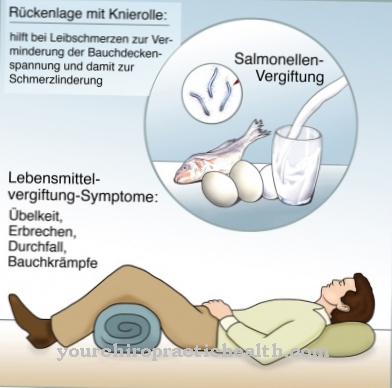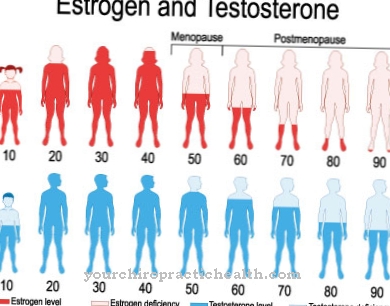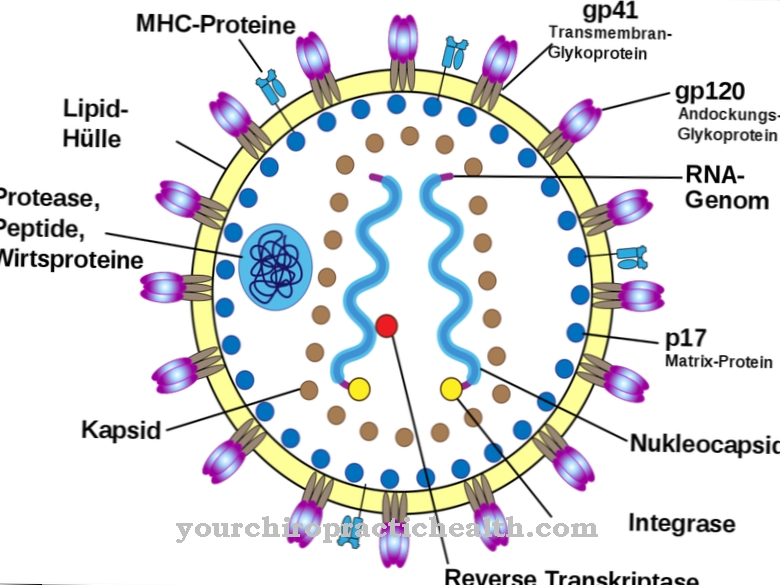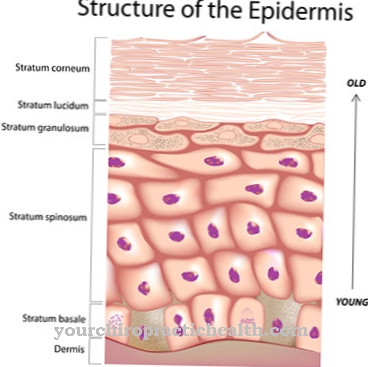Of the osmotic pressure corresponds to the pressure that is present in the solvent on the more highly concentrated side of a semipermeable or selectively permeable membrane. The pressure drives the flow of solvent through the membrane and dictates its direction. Diseases related to osmotic pressure are, for example, decreased pressure resistance of the blood cells.
What is osmotic pressure?

With the term osmotic pressure, medicine describes the physiological pressure that enables osmosis. Osmosis corresponds to the directed flow of molecular particles through semipermeable or selectively permeable separating layers. This means that osmosis is an essential transport of substances in the human body.
The osmotic pressure is the main requirement for this mass transfer process. The dissolved molecules in a solvent cause the osmotic pressure on the side of the interface with the higher concentration. The resulting pressure ratios drive the flow of the solvent through the respective membrane. In this way, the solvent moves from the side with the lower particle concentration through the membrane and thus flows to the side with the higher concentration on which the osmotic pressure exists. The molecular particles themselves cannot pass through the semipermeable or selectively permeable membrane.
Function & task
The osmotic pressure is dependent on the concentration ratios of two solutions which are located on different sides of a semipermeable or selectively permeable membrane. Although there is osmotic pressure on the lower concentrated side, the pressure is always higher on the more concentrated side of the solute.
In the human body, water flows into the individual cells from the interstitium. This influx occurs from a side with a lower concentration to a side with a higher concentration. Cells have a certain internal pressure. This pressure is also known as a turgor. The inflow continues until the turgor within the cells has reached the same level as the osmotic pressure. The pressure existing on the inside and the pressure acting on the outside are therefore equivalent at the end of the inflow.
The osmotic pressure can be measured and calculated. In principle, the same laws of physics apply in dilute liquid solutions as in ideal gases. For this reason, the osmotic pressure is always proportional to the absolute temperature in each case. In addition, there is a proportionality between the molar concentration of the particular dissolved substance and the level of the osmotic pressure. The pressure depends primarily on the number of molecular particles in the dissolved substance.
In a solution of one mole of substance in 22.4 liters of solvent, the osmotic pressure at temperatures of 0 degrees Celsius or 273.15 Kelvin is 101.325 kPa. Van ’t Hoff’s law provides these relationships. However, the law applies only to dilute solutions below a value of 0.1 M.
The analogy to the laws of ideal gases is as follows: the osmotic pressure counteracts the influx of solvents. For this reason, the inflow of solvent stops as soon as equilibrium is reached.
The osmotic pressure of a solution can be determined with osmometers. The pressure is measured either statically, after equilibrium has been reached, or dynamically. With dynamic measurement, external pressure must be applied to the riser manometer in order to interrupt the osmotic flow. By measuring the pressure, the mean molecular mass of the macromolecules can also be determined.
Illnesses & ailments
For example, diseases related to osmotic pressure can affect blood cells. The red blood cells have an osmotic resistance. This osmotic resistance of the red blood cells is reduced in various diseases. Just as many diseases are associated with an increase in osmotic resistance. In order to recognize such diseases, the osmotic erythrocyte resistance is measured. Above all, the measurement enables the diagnosis of resistance-reducing diseases.
These diseases include, for example, spheroidal cell anemia. However, other hemolytic anemias can also reduce the osmotic resistance of red blood cells. Hemolytic anemia is a group of diseases associated with anemia due to increased or premature erythrocyte breakdown. Medicine calls this fact hemolysis. Hemolysis is often associated with underlying diseases. They can be caused by mechanical processes or genetic disposition. In addition to physiological hemolysis due to the age of the erythrocytes, mechanical overuse such as heart valve replacement, thermal damage from heating and osmotic damage can determine the decay. In the case of osmotic damage, hyper- or hypoosmolar solutions are the actual cause of the decay.
To measure osmotic resistance, a patient's red blood cells are placed in tubes with increasing salt concentration. One of the tubes contains almost pure water. One contains a salt concentration that is optimal for red blood cells. After 24 hours, the blood cells burst in the pure water. In tubes with a higher salt concentration, only a few of the blood cells tend to burst. If the patient suffers from a disease with decreased osmotic resistance of the blood cells, the corpuscles burst even in higher salt concentrations and cannot resist the osmotic pressure.
The osmotic resistance can also be increased. An increase in resistance is unspecific and can be the result of various diseases. Examples of diseases with increased osmotic resistance of the red blood cells are thalassemia, iron deficiency anemia and sickle cell anemia. In addition, jaundice and liver damage can increase resistance.


























.jpg)

